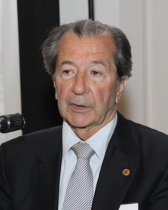Valeriy S. Petrosyan

Born March 7, 1942.
Reputed Russian and Soviet-period chemist, highly-skilled expert in the field of Environmental Toxicology and Environmental Chemistry. Professor, Lomonosov Moscow State University, Department of Chemistry, Organic Chemistry Chair. Moscow, Russia.
Rector of Open Ecological University at Lomonosov Moscow State University (1987). Full member of the Russian Academy of Natural Sciences (1990), member of the Presidium of the Russian Academy of Natural Sciences (2002). Chairman of the Ecological Council under the Government of Moscow. UN expert on Chemical Safety (2000). Honored Professor of Moscow State University (2007). Member of the Supreme Ecological Council of the State Duma of the Russian Federation. Deputy General Director for Research in the project Energy from Waste (2018).
In 1979, V.S. Petrosyan defended his doctoral habil. dissertation thesis entitled Environmental Effects in Chemistry of Organometallic Compounds of Mercury and Tin.
e-mail: petrosyan-kravt@mail.ru
Key research results:
- In 1978, V.S. Petrosyan registered a discovery related to the trans-strengthening of chemical bonds in coordination compounds of non-transition elements, in collaboration with O.A. Reutov and L.A. Aslanov;
- Investigations of qualitative and quantitative composition of mixtures of organochlorine compounds formed in the course of disinfection of natural water with molecular chlorine by means of gas chromatography/mass spectrometry resulted in discovery that these compounds have been formed as a result of chlorine cleavage of humic substances present in natural water bodies;
- High detoxifying activity of humic substances in relation to organic toxicants and heavy metals derivatives was revealed;
- Studies on bioaccumulation of organic ecotoxicants in food chains of Lake Baikal biota demonstrated that polyaromatic hydrocarbons, polychlorinated biphenyls, and DDT were the main toxicants for phyto- and zooplankton, fish, birds and seals;
- Ingestion of mercury and organotin ecotoxicants by organisms of the North Caspian Russian sturgeons was found to induce peroxide oxidation of unsaturated fats, which resulted in negative changes in fish organisms;
- A bioindication system was developed for natural water quality control at water treatment facilities, based on 24-hour monitoring the cardiac rhythm of freshwater molluscan shellfish allowing to detect severe water pollution within the space of a few minutes;
- Since 2013, research has been carried out to prevent pollution of natural water reservoirs with cyanotoxins produced by blue-green algae (cyanobacteria).
Membership information:
- Member of the International Council for Magnetic Resonance (1994);
- Member of the Council of International Network of Engineers and Scientists for Global Responsibility (1994);
- Member of the Advisory Council of the Green Cross Russia (1994);
- Member of the Council of the Society of Environmental Toxicology and Chemistry Europe (1996);
- Member of the Presidium of the Russian Ecological Congress (1997);
- Representative of the Russian Federation in Chemistry and Environment Committee of the Federation of European Chemical Societies (1999).
In 1987, V.S. Petrosyan created a program of free additional environmental educational course ‘Open Environmental University’ at Lomonosov Moscow State University which is performed on an ongoing basis. By now, more than 9000 participants obtained environmental education diploma, including listeners from the Russian Federation, Kazakhstan, and Latvia.
Author of over 500 research publications, 9 books, 25 patents, etc. Supervisor of 8 doctoral habil. dissertations and 32 PhD dissertations.











